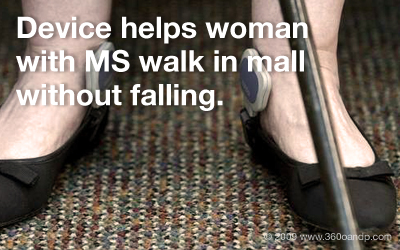
hanks to a small cuff around her leg, Bonnie Bell can walk in the mall without falling. In fact, Bell, who was diagnosed with multiple sclerosis in 1998, has not so much as tripped since she began using the Ness L300 five months ago.
Bell, a self-described "type A personality," strides across a room with a stylish black
cane and a determined smile. Vice president of sales and development and former radio personality for KTXR radio, she is a well-known face and voice in the community.
"I talk for a living, and trust me the MS has not shut me up," she quips. But when the symptoms of her MS effected her ability to walk, it was devastating and eventually dangerous.
Over a year, the problem worsened. Then, late last year, a fall sent her head crashing against a doorway and her to urgent care, where they stitched her forehead together with Super Glue. She still sports the scar. The Ness L300 has changed all that.
Foot Drop System
Bell''s trouble was caused by "foot drop," when the nerve fails to send the message to lift her toe when she takes a step. Foot drop is a common problem for people with MS, brain injury,
spinal cord injury,
cerebral palsy and
stroke. It can result in falls, improper
gait and exhaustion.
At the end of the day, Bell was wiped out from the effort to stayon her feet. Her doctor even prescribed a scooter for bad days.
On Jan. 27, 2009, an ice storm had kept Bell home when she got a phone call from an aunt who was excited about a segment she had just seen on the "Today" show. It was about a womanwith MS who went from struggling to climb stairs to climbing Diamond Head, thanks to the Ness L300.
Bell hadn''t been watching the show, but she went to the Internet to find the segment. The woman, Jonna Patton, 36,was diagnosed when she was 19. She went from a star athlete to struggling to get around her house. She was eventually fitted for the foot drop system, which uses a process called functional electrical stimulation -- FES -- to send an electrical current from just under the knee to the foot to tell it to lift for walking or climbing.
Convinced that the system could work for her, Bell began researching where she could get it. She discovered that none of the medical facilities in Springfield offered it, so she told her boss, Ken Meyer, about it.
Meyer, whose name is inscribed on the CoxHealth Meyer Orthopedic Center, called the hospital to urge them to check it out. The hospital brought in the Ness L300, produced by Bioness, and another product.
Bell and her physical therapist, Josh Layman, tried them both and found the Bioness product to provide the best results.Layman and the other therapists were trained by Bioness, and by December Cox was able to offer it to patients.
Her doctor is not surprised. "Anyone who knows Bonnie knows she''s very bright, intelligent and determined," says neurologist Steven Otto. She did the research and brought it to Otto, who also checked it out and found it was "great technology."